Module11 Body language/Unit1 They touch noses!>【课件
文档属性
| 名称 | Module11 Body language/Unit1 They touch noses!>【课件 | 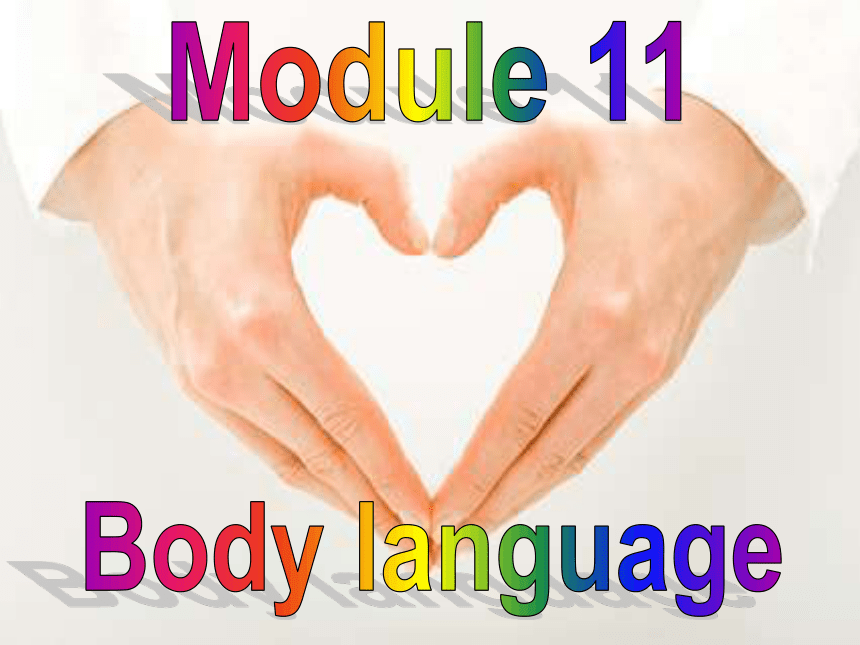 | |
| 格式 | zip | ||
| 文件大小 | 4.2MB | ||
| 资源类型 | 教案 | ||
| 版本资源 | 外研版 | ||
| 科目 | 英语 | ||
| 更新时间 | 2013-05-15 00:03:47 | ||
图片预览

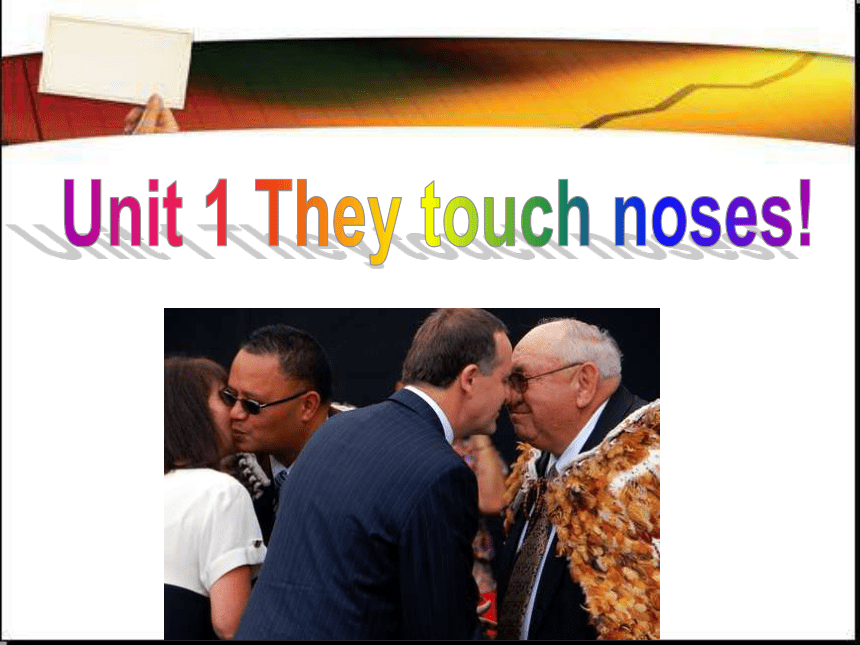


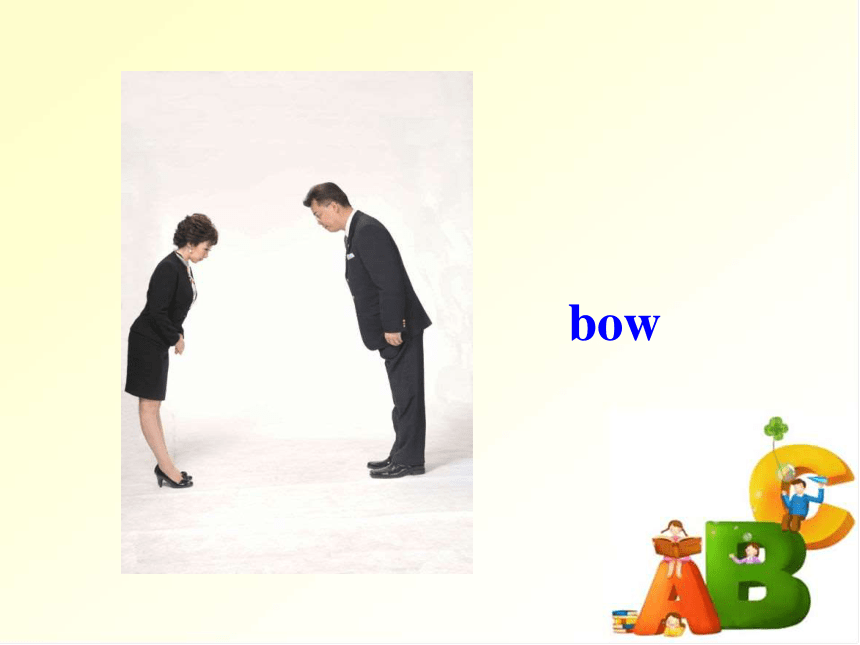

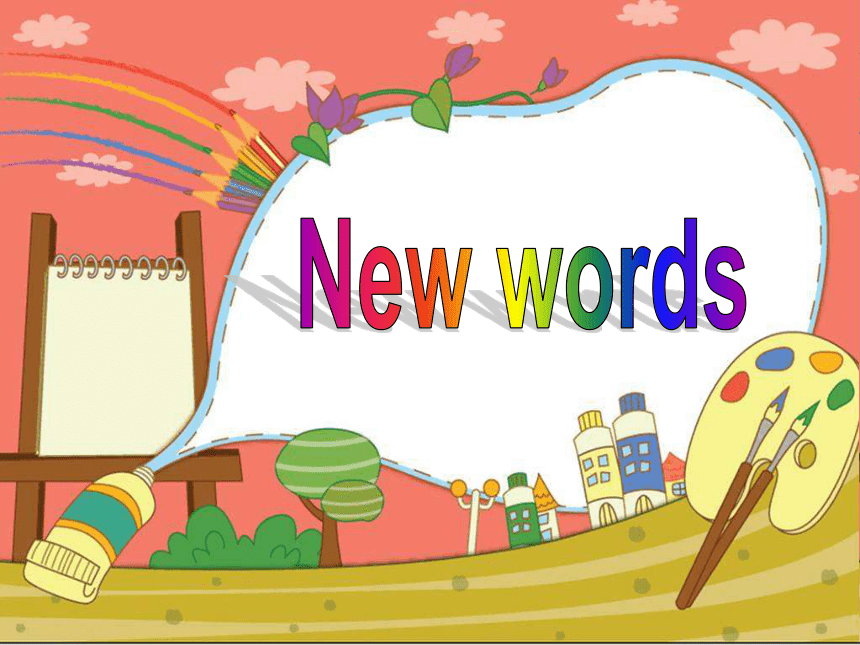
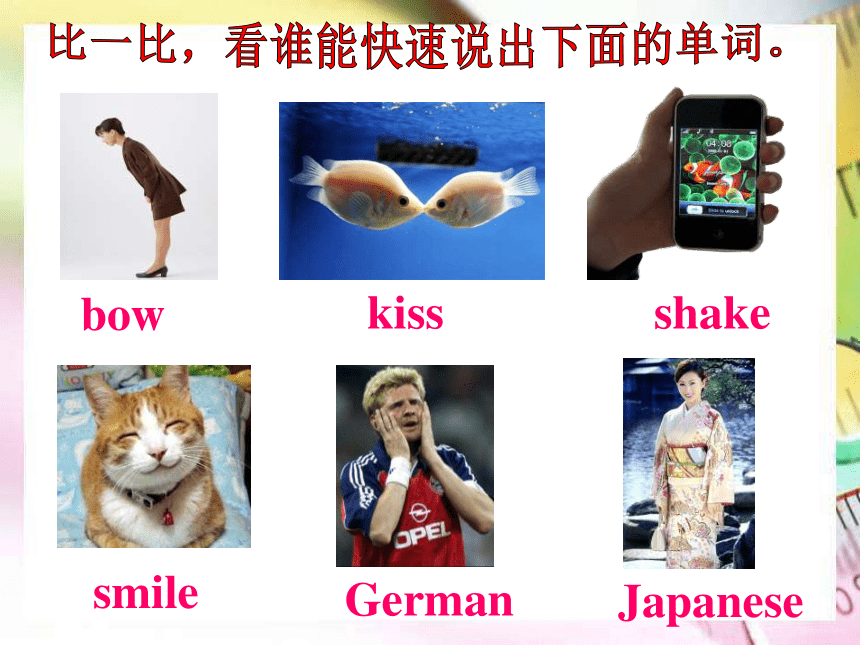
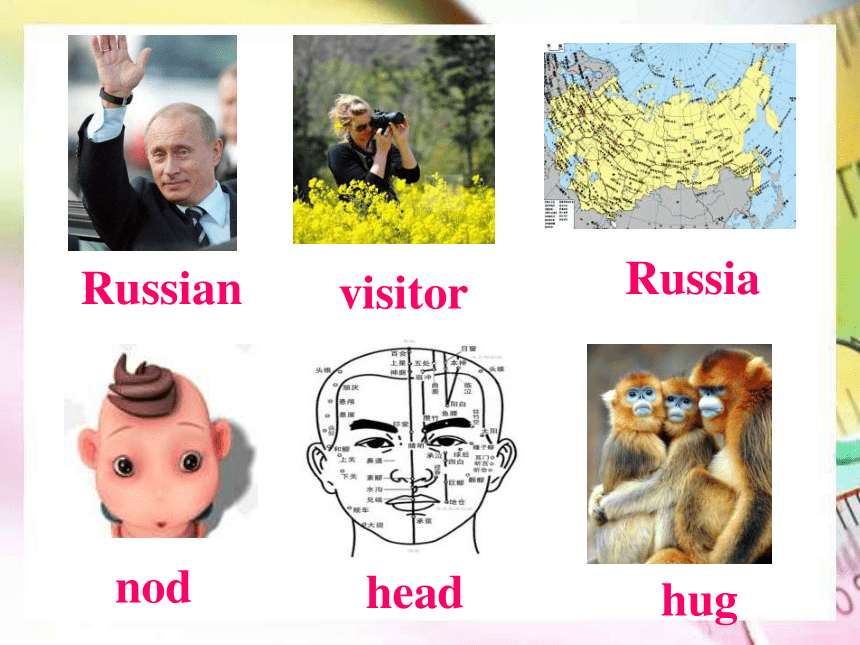
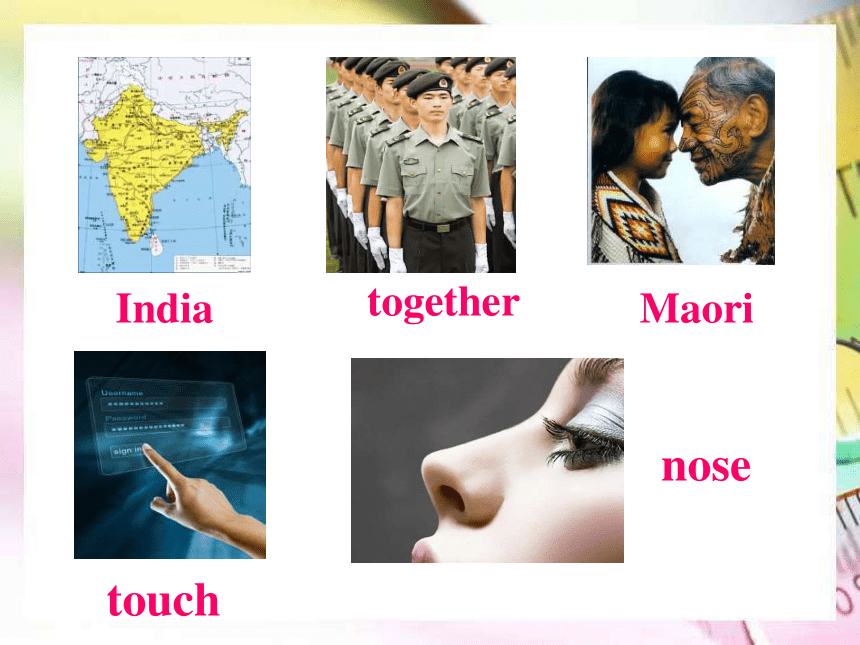
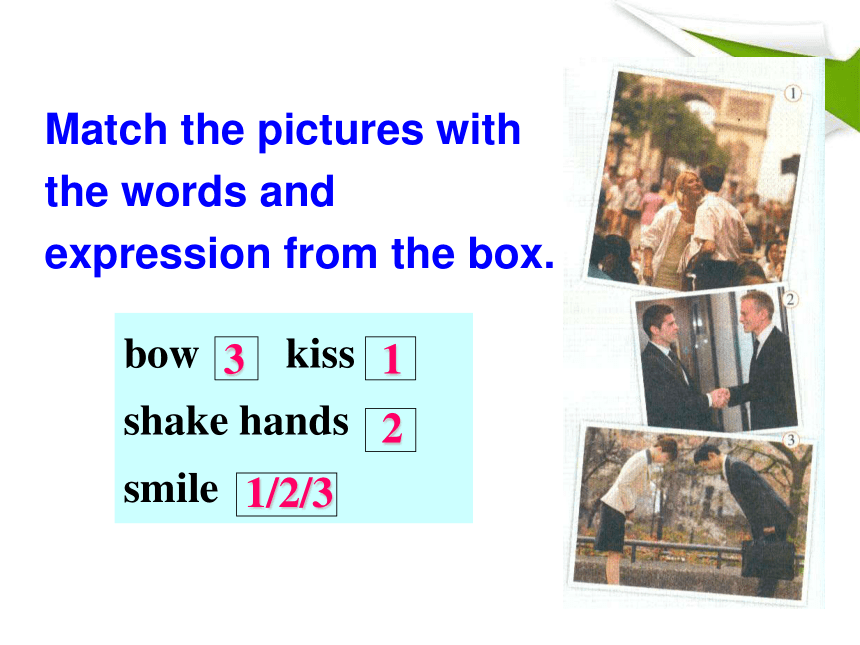
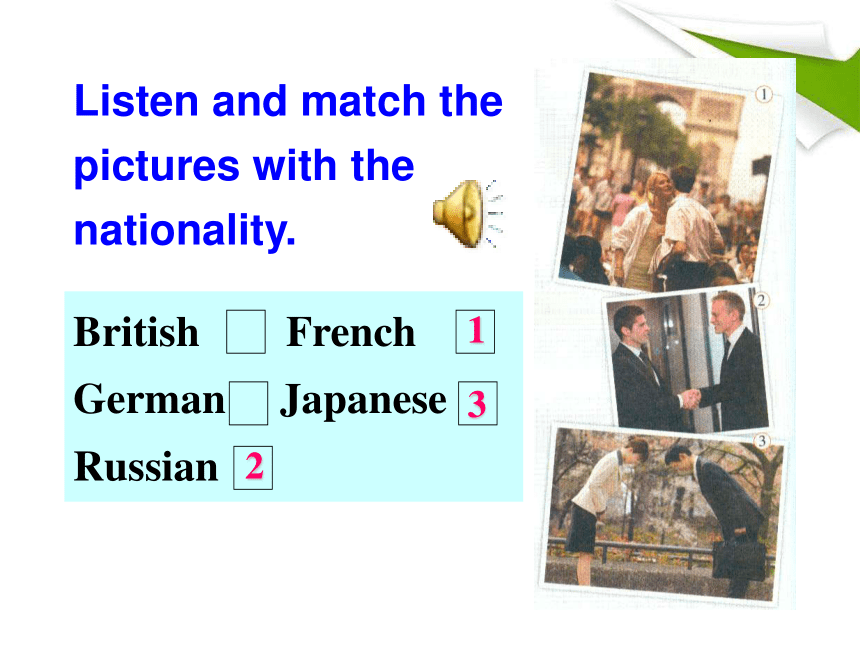
文档简介
课件31张PPT。Module 11Body languageUnit 1 They touch noses!leading-in 请说出下面的肢体语言smileshake handsbowkissNew wordsbowkissshakesmileGerman比一比,看谁能快速说出下面的单词。JapaneseRussianvisitorRussianodheadhugIndiatogetherMaoritouchnose321Match the pictures with the words and expression from the box.1/2/3Listen and match the pictures with the nationality.321Now work in pairs and check.— Are they Russian?
— Yes, they are.
— What are they doing?
— They’re shaking hands.Listen and answer.1. Who will come to Lingling’s school?
Some Russian teachers.
2. What will Maori people do when they
meet?
They will touch noses. India kiss Russia together touch visitorkissNow complete the table with the correct form of the words from the box.IndiatogetherRussiatouchvisitorsPeople in different countries may use different body language to express the same meaning and feelings. When you speak with people from other countries, try to understand
and respect their
body language.Learning to learnEveryday English What! I didn’t know that. Chinese each French
teacher touch
British shake
people
French
BritishPronunciation and speakingListen and repeat.Work in groups. your teacher
your head teacher
your parents after schoolTalk about what you do and say when you meet: your best friend
your best friend’s parents
your favourite film star
a visitor to your school
an American
a Russian— What do you do and say when you
meet your teacher in the morning?
— I smile and say good morning.— What do you do and say when you
meet a Russian?
— I smile, say hello and kiss each
other three times.— What do you do and say when you
meet your parents after school?
— Kiss and hug each other. We Chinese often shake hands and
smile.
shake hands 表示“握手”。
Shake hands with sb.
表示“和某人握手”。Language points2. 名词的复数:
German → Germans
Japanese → Japanese
Russian → Russians
3. And some kiss or hug each other.
each other 表示“彼此,互相”, 通常放
在动词后。4. In India people put their hands together
and nod their heads.
put … together 表示“把……放在一起”。
5. They touch noses!
touch noses 表示“碰鼻子”。
6. That’s because people do different
things in different countries.
That’s because … 表示“那是因为……”。 Some ______ visit the Great Wall
every year.
A. visiter B. visitor C. visitors
2. Chinese often _____ when they meet.
A. shake hands B. shakes hands
C. touch noses 练一练3. They help ______ when they are in
trouble.
A. each B. each other C. the other
4. They all live _____ in a three-bedroom
house.
A. together B. with C. each
5. Would you like to talk with _______?
A. German B. Germans
C. Germen Make a dialogue in pairs when you meet a foreigner.HomeworkThank you!
— Yes, they are.
— What are they doing?
— They’re shaking hands.Listen and answer.1. Who will come to Lingling’s school?
Some Russian teachers.
2. What will Maori people do when they
meet?
They will touch noses. India kiss Russia together touch visitorkissNow complete the table with the correct form of the words from the box.IndiatogetherRussiatouchvisitorsPeople in different countries may use different body language to express the same meaning and feelings. When you speak with people from other countries, try to understand
and respect their
body language.Learning to learnEveryday English What! I didn’t know that. Chinese each French
teacher touch
British shake
people
French
BritishPronunciation and speakingListen and repeat.Work in groups. your teacher
your head teacher
your parents after schoolTalk about what you do and say when you meet: your best friend
your best friend’s parents
your favourite film star
a visitor to your school
an American
a Russian— What do you do and say when you
meet your teacher in the morning?
— I smile and say good morning.— What do you do and say when you
meet a Russian?
— I smile, say hello and kiss each
other three times.— What do you do and say when you
meet your parents after school?
— Kiss and hug each other. We Chinese often shake hands and
smile.
shake hands 表示“握手”。
Shake hands with sb.
表示“和某人握手”。Language points2. 名词的复数:
German → Germans
Japanese → Japanese
Russian → Russians
3. And some kiss or hug each other.
each other 表示“彼此,互相”, 通常放
在动词后。4. In India people put their hands together
and nod their heads.
put … together 表示“把……放在一起”。
5. They touch noses!
touch noses 表示“碰鼻子”。
6. That’s because people do different
things in different countries.
That’s because … 表示“那是因为……”。 Some ______ visit the Great Wall
every year.
A. visiter B. visitor C. visitors
2. Chinese often _____ when they meet.
A. shake hands B. shakes hands
C. touch noses 练一练3. They help ______ when they are in
trouble.
A. each B. each other C. the other
4. They all live _____ in a three-bedroom
house.
A. together B. with C. each
5. Would you like to talk with _______?
A. German B. Germans
C. Germen Make a dialogue in pairs when you meet a foreigner.HomeworkThank you!
同课章节目录
- Module 1 Lost and found
- Unit 1 Whose bag is this?
- Unit 2 Are they yours?
- Unit 3 Language in use
- Module 2 What can you do ?
- Unit 1 I can play the piano
- Unit 2 I can run really fast
- Unit 3 Language in use
- Module 3 Making plans
- Unit 1 What are you going to do at the weekends?
- Unit 2 We're going to cheer the players.
- Unit 3 Language in use
- Module 4 Life in the future
- Unit 1 Everyone will study at home
- Unit 2 Every family will have a small plane.
- Unit 3 Language in use
- Module 5 Shopping
- Unit 1 What can I do for you?
- Unit 2 You can buy everything on the Internet
- Unit 3 Language in use
- Module 6 Around town
- Unit 1 Could you tell me how to get to the Nationa
- Unit 2 The London Eye is on your right.
- Unit 3 Language in use
- Revision module A
- Module 7 My past life
- Unit 1 I was born in a small village.
- Unit 2 I was born in Quincy.
- Unit 3 Language in use
- Module 8 Story time
- Unit 1 Once upon a time….
- Unit 2 Goldilocks hurried out of the house.
- Unit 3 Language in use
- Module 9 Life history
- Unit 1 He left school and began work at the age of
- Unit 2 He decided to be an actor.
- Unit 3 Language in use
- Module 10 A holiday journey
- Unit 1 What did you do?
- Unit 2 This morning we took a walk.
- Unit 3 Language in use
- Module 11 Body language
- Unit 1 They touch noses!
- Unit 2 Here are some ways to welcome them.
- Unit 3 Language in use
- Module 12 Western music
- Unit 1 It's so beautiful!
- Unit 2 Vienna is the centre of European classical
- Unit 3 Language in use
- Revision module B
